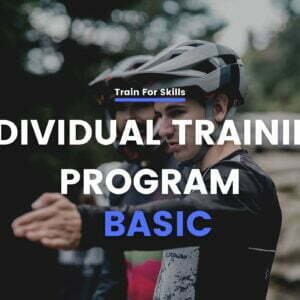How to return to training after a break?
Do you ever feel that you are behind in your training? Maybe you missed a day or two. You’ve been gone a whole week or more. You may have fallen ill or gone on vacation. Either way, you’re not sure how to get back to training. The thought of missed workouts leaves you perplexed.
This is completely understandable, given that you often hear about the principle of progressive overloading. I wrote about this myself in an earlier post about the 5 training principles. Many people talk about being systematic and measuring results. Trainers say you need to track progress every week to see progress. If you don’t increase repetitions or add weight, you won’t make progress.

There is only one but…
The reality is quite different. Life gets in the way for most people. If you systematically skip training, or even a week of training, you are in the majority of society. If anyone has not missed a training session due to illness, a trip or a meeting with friends then let him be the first to throw a stone. This message of unwavering consistency as the only way to improve fitness can be overwhelming.
Don’t get me wrong. I am not suggesting that the notion of progression and gradual overload are not important. On the contrary, they are very important and I write about it here. Our bodies are highly developed organisms that have a mission. This mission is to find homeostasis, that is, a tendency toward a relatively stable equilibrium.
In other words, our bodies are fighting change. With both positive changes and negative changes. This is why we can’t spoil our results overnight by overeating pizza, but it’s also why we can’t build strength without gradually overloading. The question is, what is more in your life?
So when does progressive overload miss the point? When as a concept doesn’t allow you to realize that not training this Friday or this week won’ t really set you back from zero. Don’t let the trend of constantly making progress paralyze you and influence you to make the wrong decisions when returning to training.
The right thing you should do is go back to the gym and just get the job done without complaining or blaming the downtime.
Do it to get back in shape quickly
When returning to training after a break, the key is to focus on the current stage you are at. A big mistake is the desire to quickly “catch up” with weights and progressions.
Absolutely do not focus on these things:
- How much did you lift last time and what exercise did you do last time. Despite what people say, if you don’t increase the load you won’t get stronger.
- At what stage of progression did you stop and how to get back to it. Despite what people say, if you don’t increase repetitions or series, you won’t build muscle.
- Did you give 110% of yourself. Despite what people say, if you don’t train to the max you are wasting your time.
If you still think that after a break from training you will go back to the way you did your training before, you may be disappointed. In addition, this mindset can increase your time to return to your previous workload.
Trying to continue training from where you left off can result:
- A feeling of discouragement because you were not able to lift the same weights
- Feeling exhausted and overworked, trying to do too much in the first few days after returning
- Exposing yourself to injury because you want too much to go back to the way things were
- Muscle pain and soreness making subsequent workouts not as effective, and you have to take an extra day or two of rest
Step by step
While getting back on track, our goal is to accumulate “small wins.” If you have already asked yourself how to get back to training, you can use 3 principles in your training to do so:
- Warm up well – make this the most important part of your time at the gym. It will help you get going and mentally prepare you for training. Remember, we use this time to improve blood circulation, work on range of motion and stability, and ultimately make training sessions more effective and avoid injury.
- Quality movement first – Your only goal when you return to training after an absence is to move purposefully and qualitatively. The most important thing should be technique and form. No junk repetitions and nothing so difficult that it gets in the way of maintaining technique.
- Strength training as a priority – I often see when people take time off and decide that before they return to strength training they will go to a fitness class, bootcamp or start with cardio training. Weightlifting and strength training should always be a priority upon return. We want to wake up the nervous system and signal to our muscles that we are getting back to work. First focus on the quality and technique of the movement, and then on the weight, which should be on the 7/10 scale. This will ensure safety, and also stimulates our nervous system and muscles. Such a strategy will give you quick and fruitful results.
If you stick to the above rules, you will soon begin to achieve the results from your previous training. This is the final step. After a few days or weeks of prioritizing warm-ups, good quality and technique during strength training, you will feel like you did before the break. Now you can again return to gradually increasing the load according to the training rules.
Return to diet
If you read carefully what I wrote above you will quickly understand that returning to diet is a very similar process to returning to training. The goal will not be an immediate and radical change in nutrition. Instead, you need to focus on “small wins.”
Let’s assume that you are after a week-long trip with friends, on which there was no shortage of alcohol and fast food. You’re home, you’ve had a good night’s sleep, and you want to get back to your eating plan. This can be difficult at first, so I recommend you use the following #backinthegame process :
- Day 1-2: Prioritize protein and ensure protein portions at each meal
- Day 2-3: Limit your intake of processed foods. Eat a minimum of one serving of vegetables and one serving of fruit.
- Day 3-5: Write down what you eat and count how many calories you consume in your normal day.
- Day 5-7: Plan a thorough nutrition plan with an appropriate calorie supply and macronutrient breakdown
A month of dietary and training self-indulgence may mean that it will take a little longer to get back on track. The longer the break, the longer the return journey will be. However, the gradual introduction of habits and dietary “corrections” will give you the confidence that it is feasible and you will quickly get back into shape.
Summary
So, how do you get back to training? Consistency in action is not measured over days, weeks, or even months. It is measured over years. A good training program, such as TFS Enduro or TFS Downhill, is designed so that you can jump in and out of it at any time. In addition, if you apply the above “back to training” principles, you will build health and fitness in no time.
Don’t worry too much about daily mistakes and departures from routine. They happen to all of us. Me too. Focus on simple things, don’t complicate or start too hard. Listen to your body and you will definitely get back on track.




